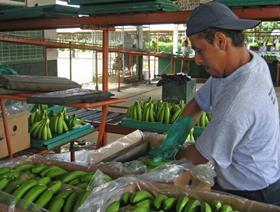
Ecuador posted a 2.31 per cent increase in banana exports in the first seven months of 2019 in spite of lower production and falling demand in some of its biggest markets.
Figures from exporter association Acorbanec show exports between January and July reached 213.07m boxes, up from 208.24m boxes in the year-earlier period.
This showed a slowdown in growth compared with the corresponding period of 2018 and 2017, when exports grew by 5.54 per cent and 3.60 per cent respectively.
The association’s executive director, Richard Salazar said a fall in shipments to the European Union, Southern Cone and Russia had been offset by a sharp rise in sendings to China, Algeria, Saudi Arabia, the UAE and Eastern Europe.
Exports to the European Union contracted by 12.84 per cent, mainly due to the increased presence of Guatemala, which has virtually doubled its shipment volume to this market compared to 2018.
Shipments to South America registered a fall of 8.54 per cent, largely as a result of the worsening economic situation in Argentina. Nevertheless, Chile and Uruguay both increased their purchases in the first seven months of the year.
In Russia, meanwhile, a 1.68 per cent fall in exports was principally due to lower demand caused by the devaluation of the rouble.
By contrast, exports to the US increased by 4.34 per cent with respect to the same period of 2018. Organic bananas, in particular, performed well and now account for around 10 per cent of shipments to the US.
The Middle Eastern market is also growing strongly and is now the third destination for Ecuadorean bananas, accounting for 14.17 per cent of total shipments or 30.2m boxes between January and July, a 9.9 per cent increase on the previous year.
In Asia, strong demand in China and Asia helped push shipment volumes up by 55.25 per cent. Problems with domestic production led to a surge in demand on the Chinese market, with exports climbing 123.5 per cent to 12.3m boxes. However, exports to South Korea and Singapore were down on the previous year.
Africa is another growing market, with shipments surging by 100.27 per cent, on the back of strong demand in Algeria and Tunisia.
Commenting on the figures, Salazar expressed “concern about the loss of important markets such as the EU and US, which together accounted for 40.38 per cent of exports from January to July of 2019, compared to 45.29 per cent in 2018 and 90 per cent 21 years ago”.
He added that the hotter European summers seen in the past three years had also impacted demand and affected prices in Ecuador.



